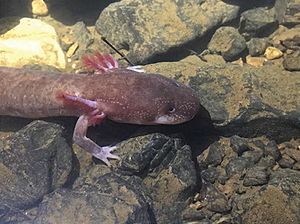Berry Cave salamander facts for kids
Quick facts for kids Berry Cave salamander |
|
|---|---|
 |
|
| Conservation status | |
| Scientific classification | |
| Synonyms | |
|
The Berry Cave salamander (Gyrinophilus gulolineatus) is a special type of salamander. It belongs to the Plethodontidae family. This salamander is found only in the Ridge-and-Valley Appalachians of eastern Tennessee in the United States. It lives underground in karst areas, which are places with caves and sinkholes. Sadly, its home is shrinking, making it an endangered animal.
What Does It Look Like?
The Berry Cave salamander looks a lot like the Tennessee cave salamander. However, it grows to be larger. It also has a wider head and a snout that looks like a spoon. Its skin has more color than the Tennessee cave salamander.
The bones at the very tip of its nose, called the premaxilla, are completely split in adult Berry Cave salamanders. This is different from the Tennessee cave salamander. Young Berry Cave salamanders, called larvae, have small eyes that can see. They can also feel vibrations in the water. They do this using special sensors on their head and sides. If they grow into full adults, their eyes stop working.
Where Does It Live?
This salamander lives in caves found in the Ridge-and-Valley Appalachians of eastern Tennessee. Its home area is smaller than that of the spring salamander. Interestingly, the Berry Cave salamander's entire range is inside the spring salamander's range. Sometimes, both types of salamanders even live in the same cave systems.
How Does It Live?
Scientists have studied the DNA of the Berry Cave salamander. They found that it is closely related to the Tennessee cave salamander and the spring salamander. It seems they all came from a common ancestor not long ago.
The Berry Cave salamander is often a paedomorphic species. This is a fancy word meaning it usually stays in its young, or larval, form. It does not go through a full metamorphosis to become an adult. Instead, it keeps its young features, like gills, and lives in the water its whole life. It can even have babies while still in its larval stage.
Why Is It Endangered?
The Berry Cave salamander lives in only a few caves in the mountains of East Tennessee. The total area where it lives is quite small, less than 5,000 square kilometers (about 1,930 square miles). In the Berry Cave, which is where it got its name, the number of these salamanders seems to be going down. We don't know exactly how many there are in total.
Because of these reasons, the International Union for Conservation of Nature (IUCN) has listed the Berry Cave salamander as "endangered." This means it is at a very high risk of disappearing forever. The IUCN suggests that we need to protect the water systems that flow into the underground caves where these salamanders make their home.


